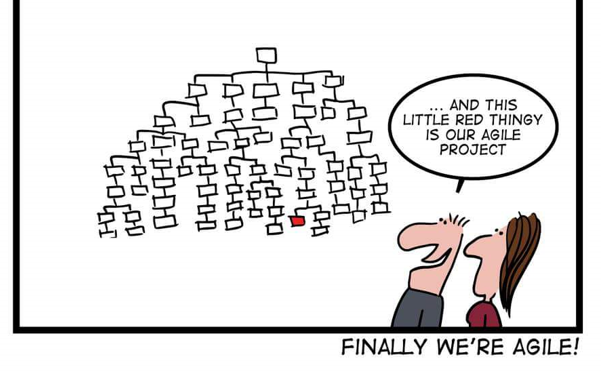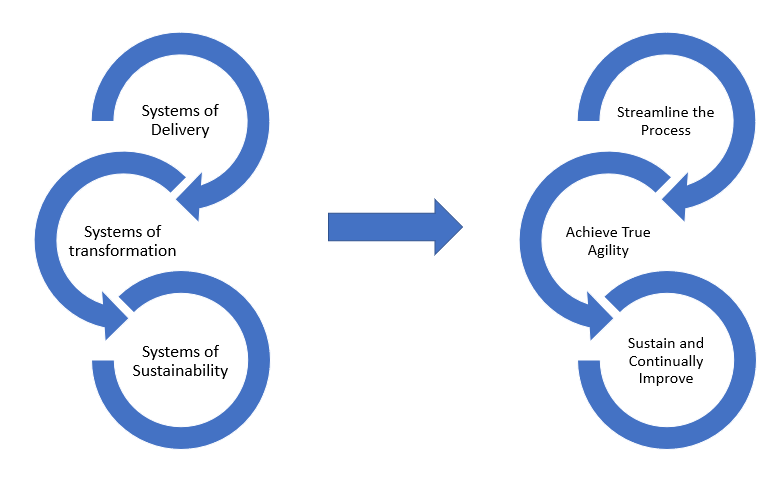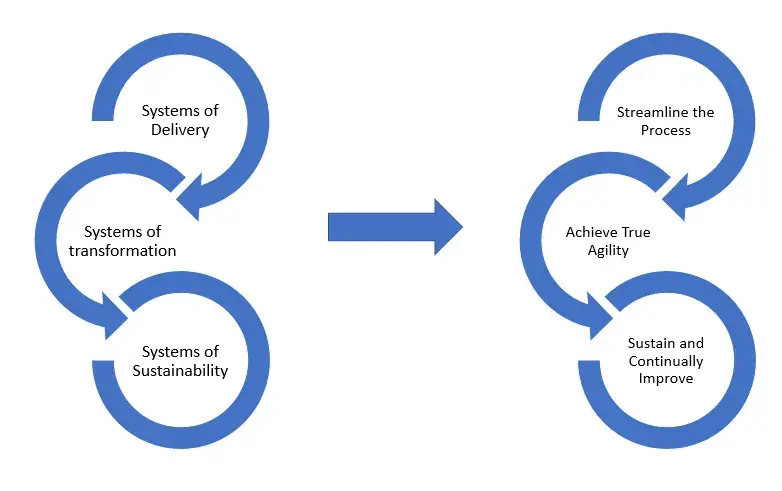We have seen Agile being tried out in many teams across various organizations. Some of the features that we might observe is that they following some of the Scrum ceremonies like daily scrum or retrospective (or) using certain tools like JIRA and Rally. And the saddest part is they might think that they are already Agile by doing some of these things. I have addressed some of these myths that the organizations have about Agile in this post – https://pm-powerconsulting.com/blog/being-clear-on-what-is-not-agile/. Some teams might still make good efforts to understand the true meaning of Agile, undergo some trainings and the Leadership are more serious about Agile adoption. These teams might start seeing part of their process being streamlined. And this process may aid their delivery process well. However, there are not many teams that derive complete benefits of what Agile has to deliver. There could be certain exceptions, where some teams achieve high Agility either because of the inherent high performance culture or because they have been effectively coached. They might see their time to market increasing, their value delivery getting better with every Sprint and also an enhanced quality of their deliveries. These are the true outcomes of Agility. However, they may not be able to sustain their Agility for a longer time. And the reason for this in most of the cases would be that the the system around them is all Non-Agile. The picture below depicts the situation where a small team in a huge system is Agile. But it would not remain so for long mainly because of the powerful influence that the system would exert on that small team.

This is what builds the case for Systemic Agility. It is about applying Systemic thinking to to their Agile Transformations. Systems thinking is a way of making sense of the complexity of the world by looking at it in terms of wholes and relationships rather than by splitting it down into its parts. Some of the essential characteristics of Systems thinking 9Ref: Peter Senge) are as follows:
- A consistent and strong commitment to learning.
- A willingness to challenge your own mental model
- Including multiple perspectives when looking at a phenomenon.
- The circular nature of Systems instead of arriving at direct cause-effect relationships in a linear way
- Inter-connection and dependencies of various elements in the system.
- The feedback loops with-in the system.
There are many elements of Systemic thinking that is already in-built in Agile. And it helps to just list out some of those elements here. Vertical slicing of stories makes sure that we are not just taking either UI, Middleware or a Database layer but considering the whole. Individuals and Interactions ensure that we are seeing things from the multiple perspective. And when we do not consider customer requirements as the gospel but are willing to challenge them to satisfy the needs, we are making sure that we are challenging their mental model. Each Sprints and the learning that emerges from each Sprint ensures that learning happens in circles and it is continuous in nature. The feedback loops that is established with the customers ensure that the validation happens every Sprint and we do not have to wait till the end of the project to check if it meets the customer expectations or not. Most of the Agile Frameworks be it Scrum and Kanban or even Scaled agile frameworks like SAFe and LeSS have most of these aspects built in. They primarily address the delivery aspects of the team, which is fundamental for the teams to exist. They mostly take care of the aspects on forming teams, Backlog Management and Delivering the working software. It is important for the teams to do these aspects well so that the initial trust is built between Customer and the Delivery teams and also on the Agile ways of working. We can call this Systems of Delivery. (Ref: Mike Cottmeyer, Leading Agile).
While Agile is inherently systemic, the way it is implemented in the organization, which can be termed as a Systems of Transformation is a key focus area that most of the organizations miss. If we do not get this right, even the basic benefits of Agile that is discussed above are not realized by the client. We know that many Agile transformations fail due to multiple reasons. And one of the reasons for the same is that Agile is not implemented as a Systemic Change but is only implemented in parts. I have mentioned this in detail in the following blog – https://pm-powerconsulting.com/blog/systems-thinking-for-organizational-change/. In this post, I have elaborated what are the components required to be considered to bring in Systemic change and how this would bring in more sustainable change. Some of the successful transformational patterns that I have experienced are as follows:
- Make the transformation outcome driven and it attach it to business outcomes
- Create an Eco-system for Systemic Change to happen i.e. set up the transformation for success
- Focus on creating visible changes, this is what fosters confidence among all the parties involved
- Make the transformation progress visible to the stakeholders and evaluate the same on a continuous basis
- Get the larger part of the organization to participate in the initiative and let that not just be a job of an Agile Coach
- Start with Why – The golden ring model
- Keep the coaching interventions experiential – Kolb’s learning model
- Keep surfacing the problems – Toyota’s rocks under water metaphor
- Co-create the solution with all the stakeholders
I have mentioned the first 5 in detail in my blog: https://pm-powerconsulting.com/blog/rebooting-agile-key-patterns-to-succeed/. And the last 4 I have elaborated in another blog post: https://pm-powerconsulting.com/blog/images-that-inspired-a-successful-change/. All of these put together can be called as Systems of Transformation.

Now, about the last bit which is Systems of Sustainability. These systems are about making the transformation stick and not being dependant on the coaches. And one way to do it is by passing the ownership of the transformation to the teams and organizational leadership. It is about building reinforcing mechanisms. Large part of this depends on Leadership, the way they role model the change. I have mentioned about the aspects of Agile Leadership in this post – https://pm-powerconsulting.com/blog/transitioning-to-an-agile-leader/. And then there is a need to create Agile champions with-in who can take the culture of Agility forward. There needs to be an emphasis on cultural change from the beginning of the transformation. While the Coach holds that space initially, the ownership transfer needs to happen gradually. Cultural change is about the change in belief system of the people involved in the organization. These are the conditional patterns that the people in the organization would have learnt to say – “This is how things work in our organization”. There is a need to break these patterns of thinking and feeling. I have referred to these as Organizational Ideologies and have discussed the same in my blog post – https://pm-powerconsulting.com/blog/understanding-organizational-ideology-key-step-to-cultural-change/. How the organizations see the following aspects – Agile, Work, Growth, Team and Customers is what separates the traditional leadership ideology to Agile leadership ideology. If Agile is seen as an initiative or “flavour of the season”, that is just a façade or if it is seen as an opportunity to increase the effectiveness and drive high performance culture.
Another important step in the cultural change is availability of data for the team to make its own decisions. There is a need to change from the Management driven culture to the Data driven culture. While having facilitative leadership like (mentioned above) would help, the team would also need the access to management data to self-organize. And that is possible by having a good visual management system (VMS) as mentioned in this post – https://pm-powerconsulting.com/blog/designing-interactions-with-visual-system-key-to-achieving-agility/. Designing and following a good VMS facilitates a change in culture. I have out lined some of the differences between the 2 cultures based on my experience. Here is how the difference cultural change happened because of the effective use of VMS. Access to data and making decisions based on what you see is major part of the cultural transformation for teams that were used to mostly follow what the Management would instruct.
| Management Driven Culture | Data Driven Culture |
| Management is more concerned about resource utilization; the team fills in their time and justifies. | Focus is more on value and movement of workitems from start to finish. |
| The team would show up as if everything is going as per the plan. No transparency. | Team members ensure they update their data daily, even if it is not as per the plan. Complete transparency |
| Project Manager along with the Leads make all the decisions. | Decisions are taken by the team members because they have the access to all the management data |
| Meetings usually take longer time depending on the needs of the Management. | Meeting starts on time and ends on time. Facilitated by the Scrum Master |
| Management intends to control the time structure. | Team takes the delivery accountability and decide their time structure based on the pending work. |
| Excel sheets are used for managing work; | VMS was used extensively and during the meetings, they were used to visualize the progress |
| The meetings were inconsistent and mechanical | The meetings would happen regularly and were more involved |
| Multiple reporting using PPTs – RAG Status but mostly reported Green. | No PPT reports. Graphical indicators on VMS to check if the team is going to meet the goals or not |
Focusing on the process like the ceremonies, roles and backlog would help the teams to streamline the process and provide a structure to the delivery process (Refer to the figure on Systemic Agility). This would make sure that the delivery is happening in a predictable way and there is a regular feedback that is received from the customers. To take this one step forward, we need to focus our process of transformation. How are we making this change, why are we moving towards Agile? Is it just to streamline the process (or) achieve “True Agility”. If it is the latter, then we need to start from the outcomes – Begin with the end in mind. We need to use Agile as a means to achieve our Business Outcomes rather than merely using them as a methodology and an end in itself. This is where successful transformation patterns which includes outcome driven agility would help. Finally, it is not enough if we achieve this but are not able to sustain it. So, the final cog in the wheel of Systemic Agility would be work on cultural change. Here the focus is on understanding the conditioned patterns and making a conscious effort to change that through experiential learning. That is where the systems of sustainability would help. This is what is pinnacle of Agile Transformation. Expecting anything less would be under-utilization of ideas that Agile promises.




